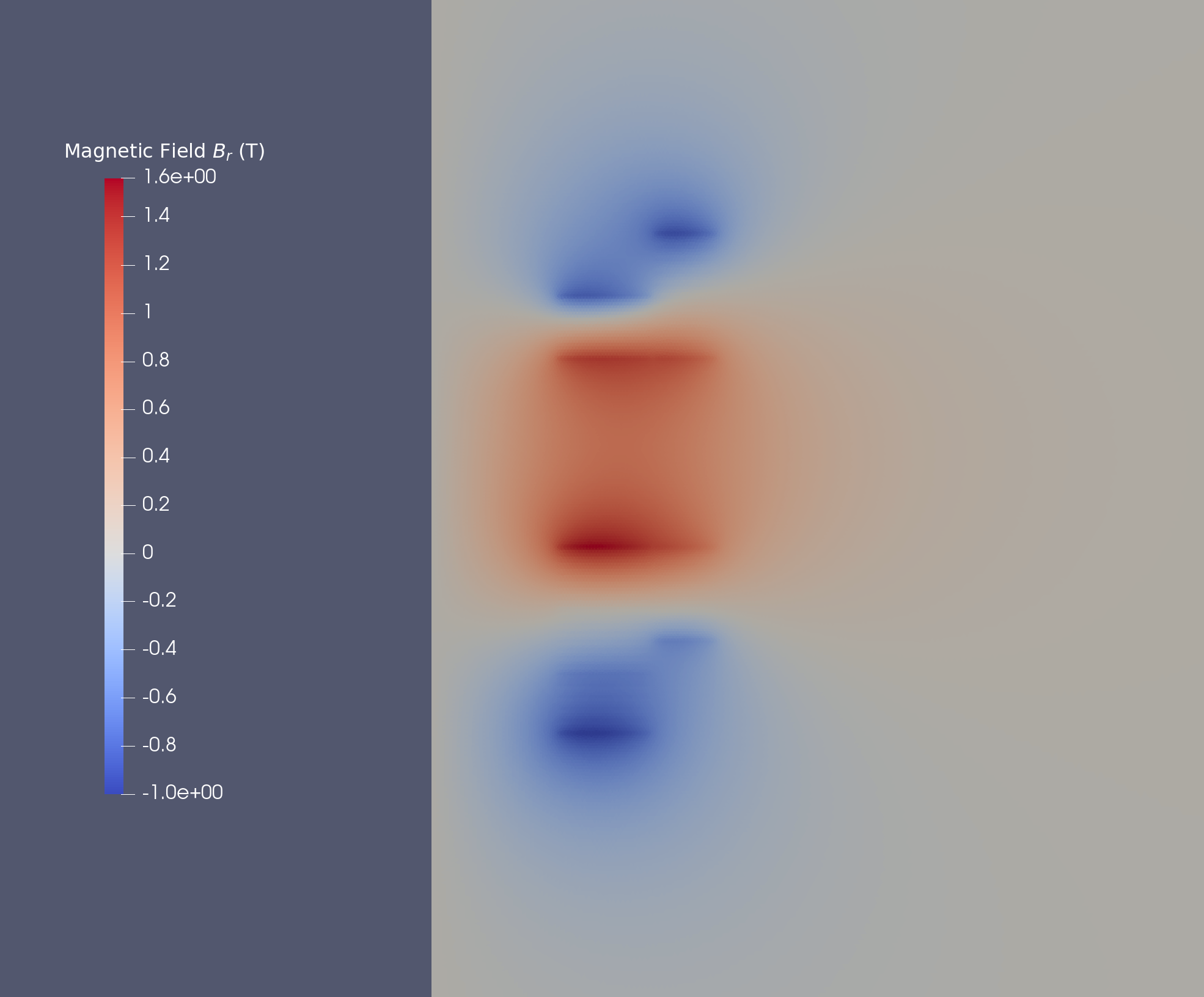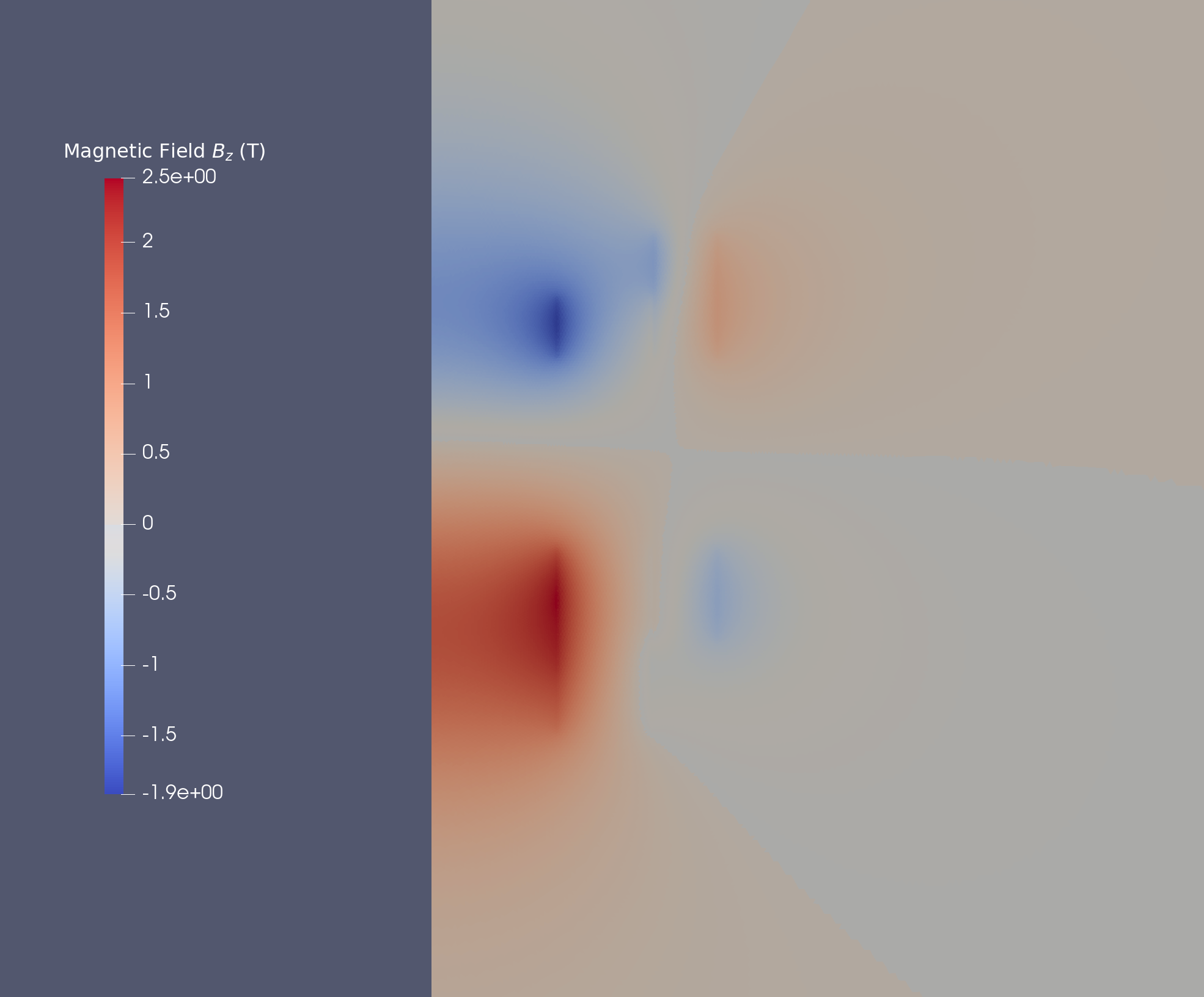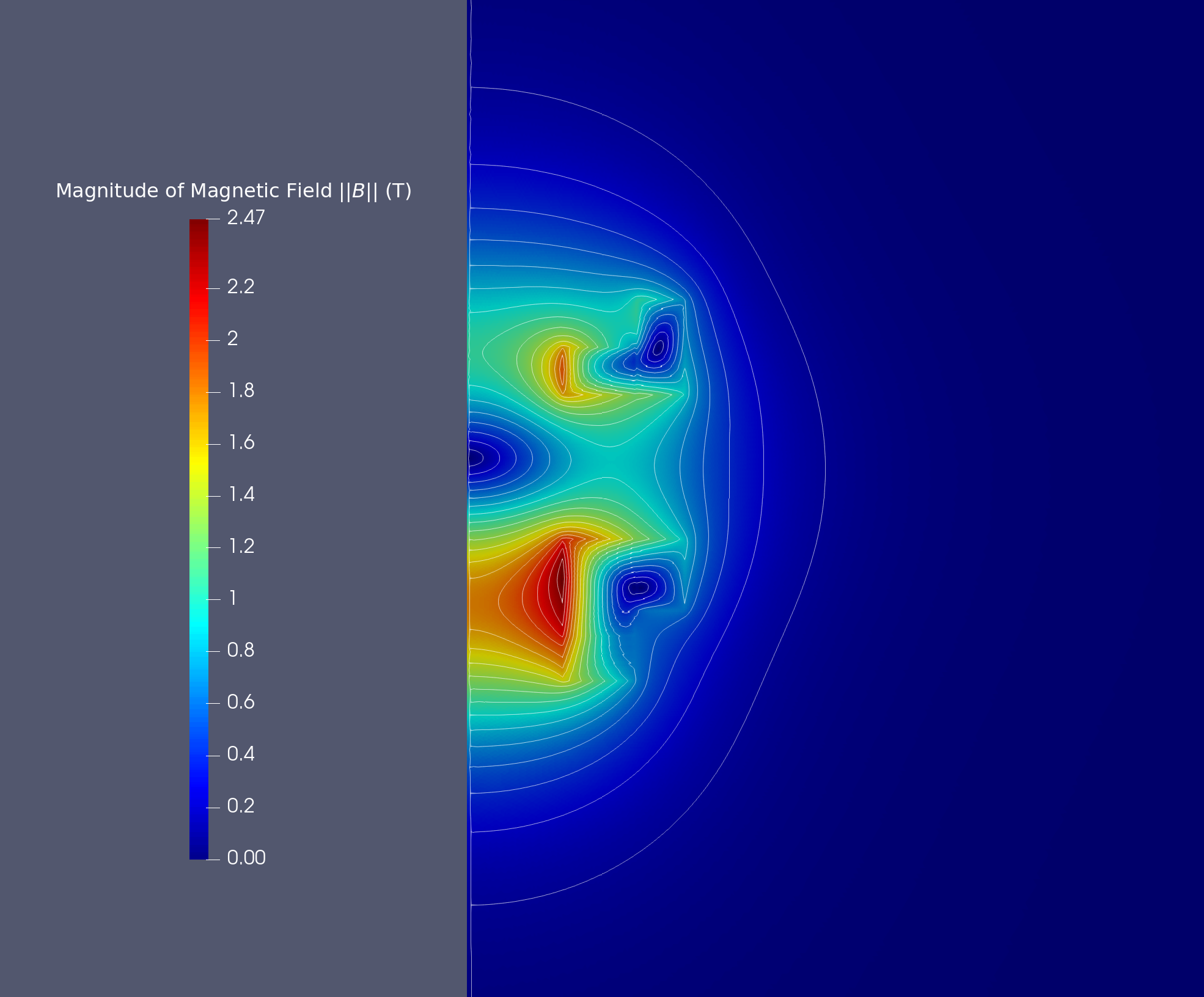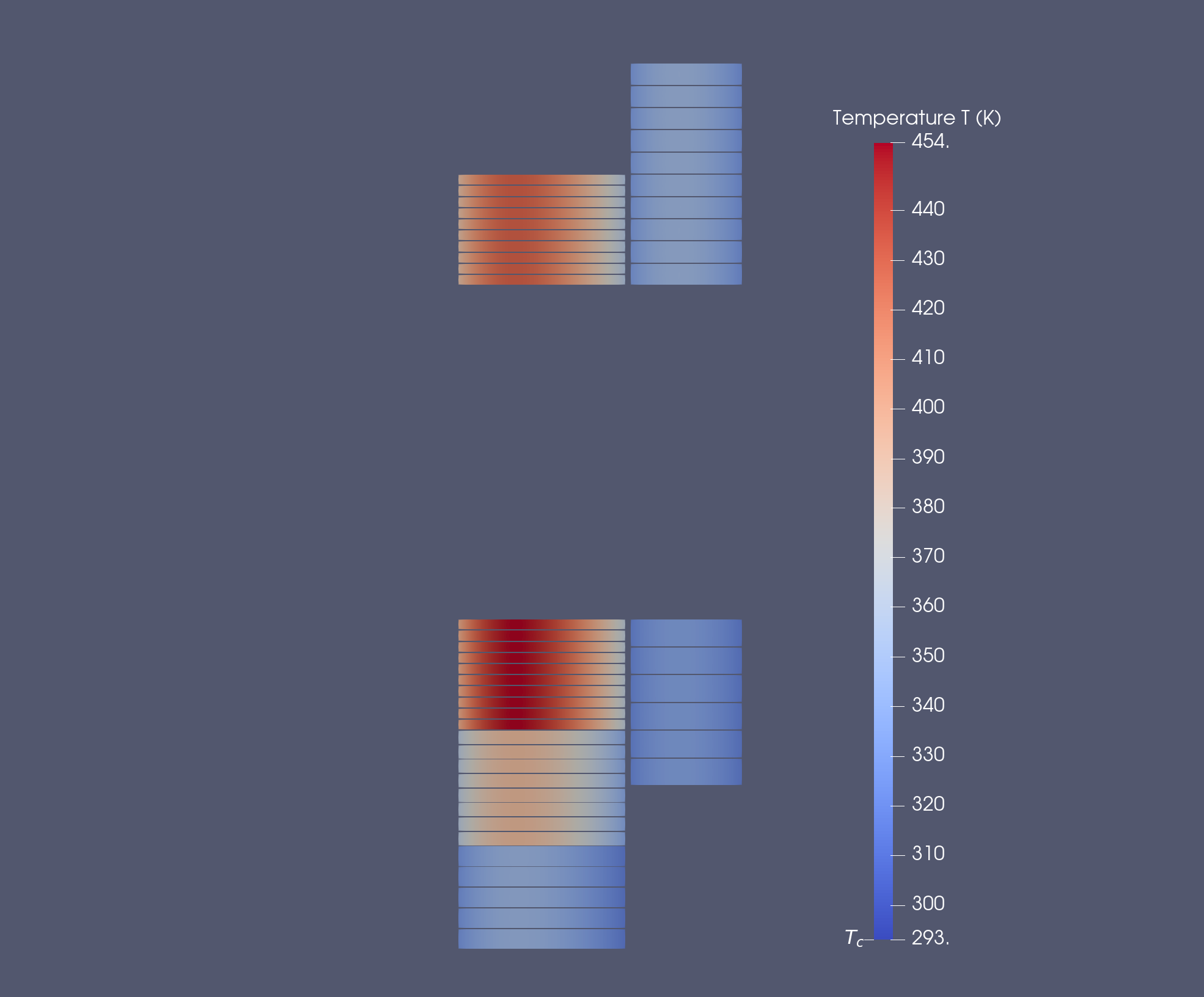SEISM
1. Introduction
The LPSC (Laboratoire de Physique Subatomique & Cosmologie) has developed SEISM, the first and unique confinement structure in the world that allows a closed ECR zone, using advanced magnet technology from LNCMI Grenoble (High Magnetic Field Laboratory).
An ECR zone is a zone of plasma formation.
This page presents the simulation thermo-magnetism problem of SEISM in axisymmetrical case by CoefficientForm PDE’s, an application of LNCMI.
2. Run the calculation
The command line to run this case is :
To generate the mesh :
gmsh -2 -bin Chambre_1.geoTo search the tensions associated to desired intensities :
python3 seism.pyTo run the simulation in transient case :
mpirun -np 16 feelpp_toolbox_coefficientformpdes --config-file=seism.cfg3. Data Files
The case data files are available in Github here :
-
-
PYTHON file - Edit the file
-
CFG file - Edit the file
-
JSON file - Edit the file
-
GEO file - Edit the file
-
The files of configuration and parameters to simulate the static case and used by python’s script are seism_static.cfg and seism_static.json.
-
-
PYTHON file - Edit the file
-
CFG file - Edit the file
-
JSON file - Edit the file
-
GEO file - Edit the file
-
The folder seism-detail contains the same files but for an geometry with physical group more detailed.
4. Equation
In this subsection, we retake the coupled equation (AV+Heat Axis) of Heat equation and AV-Formulation in axisymetrical coordinates with new coefficients.
The domain of resolution of electromagnetism part is \(\Omega^{axis}\) with bounds \(\Gamma^{axis}\), \(\Gamma_D^{axis}\) the bound of Dirichlet conditions and \(\Gamma_N^{axis}\) the bound of Neumann conditions such that \(\Gamma^{axis} = \Gamma_N^{axis} \cup \Gamma_D^{axis}\).
The domain of resolution of heat part is \(\Omega_c^{axis} \subset \Omega^{axis}\) (and the domain of definition of electrical potential \(V\) and electrical conductivity \(\sigma\)) with bounds \(\Gamma_c^{axis}\), \(\Gamma_{Dc}^{axis}\) the bound of Dirichlet conditions and \(\Gamma_{Nc}^{axis}\) the bound of Neumann conditions such that \(\Gamma_c^{axis} = \Gamma_{Nc}^{axis} \cup \Gamma_{Dc}^{axis}\).
With :
-
\(\Phi = r \, A_{\theta}\), with magnetic potential field \(\mathbf{A} = \begin{pmatrix} A_r \\ A_{\theta} \\ A_z \end{pmatrix}_{cyl}\) such that the magnetic field is writed \(\mathbf{B} = \nabla \times \mathbf{A}\)
-
\(T\) : temperature \((K)\)
-
\(\sigma\) : electric conductivity \((S/m)\)
-
\(\mu\) : electric permeability \((kg/A^2/S^2)\)
-
\(\rho\) : density \((kg/m^3)\)
-
\(C_p\) : thermal capacity \((J/K/kg)\)
-
\(k\) : thermal conductivity \((W/m/K)\)
-
\(U\) : tension \(Volt\)
We run the simulation in two cases :
-
with Linear coefficients : the electrical conductivity \(\sigma\) and thermal conductivity \(k\) are constant.
-
with Non-Linear coefficients : the electrical conductivity \(\sigma = \frac{\sigma_0}{1 + \alpha \, \left( T - T_0 \right)}\) and thermal conductivity \(k = \frac{k_0}{1 + \alpha \, \left( T - T_0 \right)} \, \frac{T}{T_0}\) with \(T_0\) temperature of reference, \(sigma_0\) the electrical conductivity of at temperature of reference, \(k_0\) the thermal conductivity at temperature of reference and \(\alpha\) temperature coefficient.
5. Geometry
The axisymmetrical geometry of SEISM is composed by 4 Helix :
-
Two Helix of Injection
-
Helix1+Helix2+Helix3the first helix -
Helix5the second
-
-
Two Helix of Ejection
-
Helix4the first -
Helix6the second
-
-
All
Helixihave the bounds :-
RChanneli: the bound of inter-spire -
Rinti: the interior bound of spires -
Rexti: the exterior bound of spires
-
-
The
Airsurrounding the helix-
Air: the exterior air -
AifInf: the interior air -
Axis: \(Oz\) axis -
Infini: the bound ofAxis
-
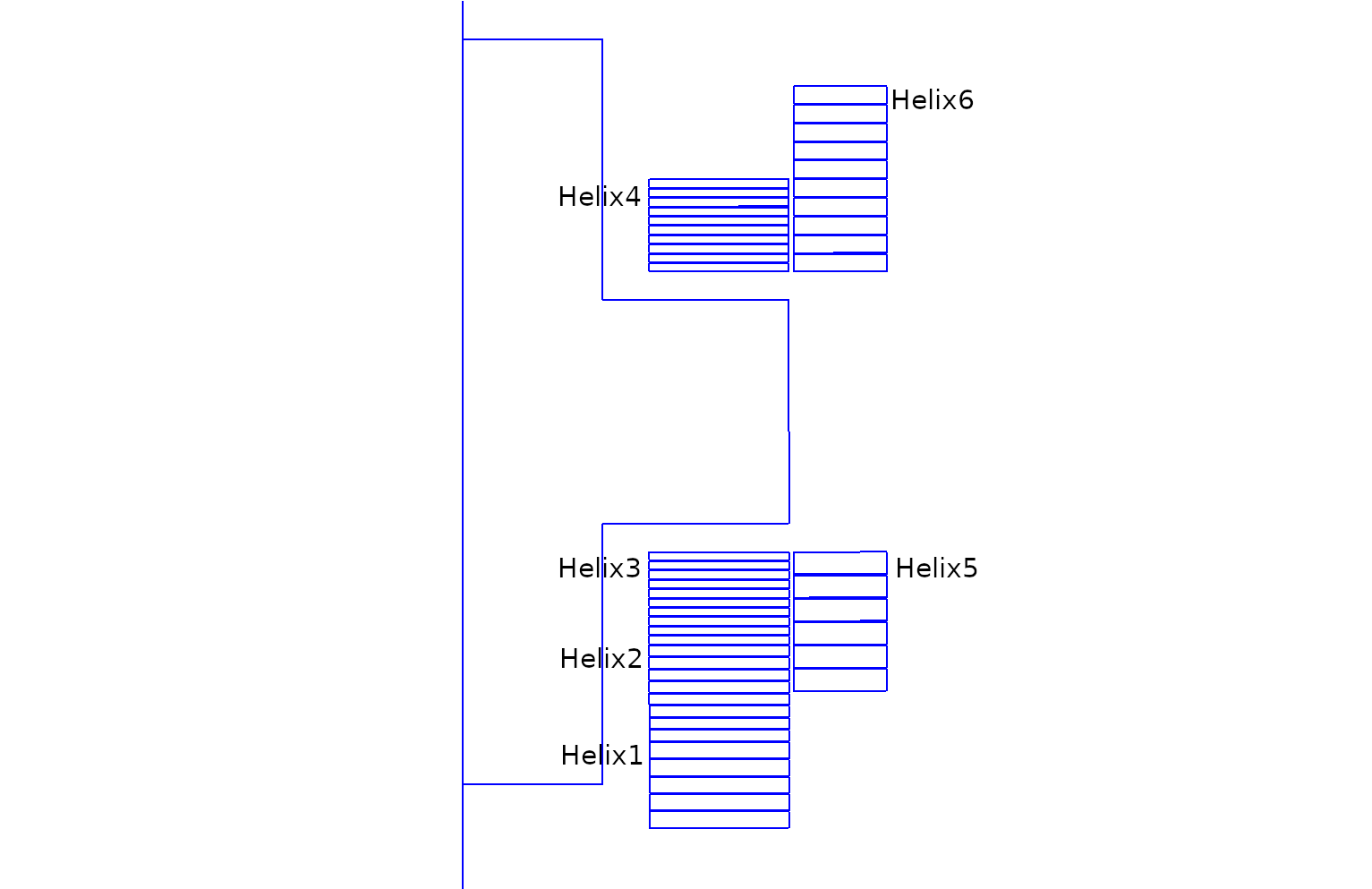
Geometry of SEISM
|
.png)
Geometry of
Helix5 |
The physical groups Helixi is composed by \(n_{spire \, i}\) of half-height \(z_i\), interior radius \(r_{int \, i}\) ans exterior radius \(r_{ext \, i}\) :
Geometrical Parameter |
|
|
|
|
|
|
Unit |
\(n_{spire}\) |
5 |
8 |
10 |
10 |
6 |
10 |
|
\(z_i\) |
\(3.73\) |
\(26\) |
\(2.0\) |
\(2.0\) |
\(5.0\) |
\(4.0\) |
\(mm\) |
\(r_{ext}\) |
\(40\) |
\(40\) |
\(40\) |
\(71\) |
\(40\) |
\(71\) |
\(mm\) |
\(r_{int}\) |
\(70\) |
\(70\) |
\(70\) |
\(91\) |
\(70\) |
\(91\) |
\(mm\) |
Symbol |
Description |
Value |
Unit |
\(r_{inf}\) |
Intermediate radius of |
\(1.5\) |
\(m\) |
\(r_{ext}\) |
Radius of Boundary of |
\(3\) |
\(m\) |
6. Initial/Boundary Conditions
We impose the boundary conditions :
-
Dirichlet :
-
On
Axis: \(\Phi = 0\) (\(A_{\theta} = 0\) by symetric argument) -
On
Infini: \(\Phi = 0\) (\(A_{\theta} = 0\) we consider the bound of resolution like infty for magnetic field)
-
-
Robin :
-
\(-k \, \frac{\partial T}{\partial \mathbf{n}} = h_{int} \, \left( T - T_c \right)\) on
Rinti -
\(-k \, \frac{\partial T}{\partial \mathbf{n}} = h_{ext} \, \left( T - T_c \right)\) on
Rexti -
\(-k \, \frac{\partial T}{\partial \mathbf{n}} = h_{ch} \, \left( T - T_c \right)\) on
RChanneli
-
On JSON file, the boundary conditions are writed :
"BoundaryConditions":
{
"magnetic":
{
"Dirichlet":
{
"magdir":
{
"markers":["Axis","Infini"],
"expr":"0"
}
}
},
"heat":
{
"Robin":
{
"heatrobin_int":
{
"markers":["Rint1","Rint2","Rint3","Rint4","Rint5","Rint6"],
"expr1":"h_int*x:h_int:x",
"expr2":"h_int*T_c*x:h_int:T_c:x"
},
"heatrobin_ext":
{
"markers":["Rext1","Rext2","Rext3","Rext4","Rext5","Rext6"],
"expr1":"h_ext*x:h_ext:x",
"expr2":"h_ext*T_c*x:h_ext:T_c:x"
},
"heatrobin_channel":
{
"markers":["RChannel1","RChannel2","RChannel3","RChannel4","RChannel5","RChannel6"],
"expr1":"h_ch*x:h_ch:x",
"expr2":"h_ch*T_c*x:h_ch:T_c:x"
}
}
}
}
We initialize :
-
On
Helix\(\Phi(t=0,r,z) = 0\) (\(A_{\theta}(t=0,r,z) = 0\)) and \(T(t=0,r,z) = T_i\) -
On
Air\(\Phi(t=0,r,z) = 0\) (\(A_{\theta}(t=0,r,z) = 0\))
On JSON file, the initial conditions are writed :
"InitialConditions":
{
"temperature":
{
"Expression":
{
"inittemp":
{
"markers":["Helix1","Helix2","Helix3","Helix4","Helix5","Helix6"],
"expr":"T_i:T_i"
}
}
}
}
7. Weak Formulation
8. Parameters
The parameters of problem are :
-
On all
Helixi:
Physical Parameter |
Description |
Value on all |
Units |
\(\mu=\mu_0\) |
magnetic permeability of vacuum |
\(4\pi \times 1e-7\) |
\(kg.m/A^2/S^2\) |
\(h_{int}\) |
convective coefficient on interior |
\(4.12e4\) |
\(W/m^2/K\) |
\(h_{ext}\) |
convective coefficient on exterior |
\(4.12e4\) |
\(W/m^2/K\) |
\(h_{ch}\) |
convective coefficient inter spire |
\(1000\) |
\(W/m^2/K\) |
\(T_c\) |
cooling temperature |
\(293\) |
\(K\) |
\(T_i\) |
initial temperature |
\(293\) |
\(K\) |
\(\alpha\) |
temperature coefficient |
\(3.6e-3\) |
dimensionless |
\(\sigma\) |
electrical conductivity |
\( \left\{ \begin{matrix} \sigma_0 \text{ for Linear case} \\ \frac{\sigma_0}{1+\alpha (T-T_0)} \text{ for Non-Linear case} \end{matrix} \right. \) |
\(S/m\) |
\(k\) |
thermal conductivity |
\( \left\{ \begin{matrix} k_0 \text{ for Linear case} \\ \frac{k_0}{1+\alpha (T-T_0)} \frac{T}{T_0} \text{ for Non-Linear case} \end{matrix} \right. \) |
\(W/m/K\) |
Physical Parameter |
Description |
|
|
|
|
|
|
Units |
\(\sigma_0\) |
electrical conductivity at reference temperature |
\(4.46e7\) |
\(4.46e7\) |
\(4.46e7\) |
\(5.02e+07\) |
\(4.46e7\) |
\(5.02e+07\) |
\(S/m\) |
\(k_0\) |
thermal conductivity at reference temperature |
\(340\) |
\(340\) |
\(340\) |
\(380\) |
\(340\) |
\(380\) |
\(W/m/K\) |
\(C_p\) |
thermal capacity |
\(380\) |
\(380\) |
\(380\) |
\(380\) |
\(380\) |
\(380\) |
\(J/K/kg\) |
\(\rho\) |
density |
\(10000\) |
\(10000\) |
\(10000\) |
\(10000\) |
\(10000\) |
\(10000\) |
\(kg/m^3\) |
-
On
Air:
Physical Parameter |
|
\(\mu=\mu_0\) |
\(4\pi.10^{-7} \, kg \, m / A^2 / S^2\) |
On JSON file, the parameters are writed :
"Parameters":
{
"n_spire_Helix1":5,
"n_spire_Helix2":8,
"n_spire_Helix3":10,
"n_spire_Helix4":10,
"n_spire_Helix5":6,
"n_spire_Helix6":10,
"U_Helix1":-0.4992043785599384, // Volt
"U_Helix2":-0.7342464401319103, // Volt
"U_Helix3":-0.9789952535092106, // Volt
"U_Helix4":0.8697846832894235, // Volt
"U_Helix5":-0.8278195535256483, // Volt
"U_Helix6":0.9290187741745279, // Volt
"T_c":293, // K
"T_i":293, // K
"T0":293, // K
"mu":"4*pi*1e-7", // kg.m/A2/S2
"h_ext":4.12e+4, // W/m2/K
"h_int":4.12e+4, // W/m2/K
"h_ch":1000 // W/m2/K
}
9. Coefficient Form PDEs
We use the application Coefficient Form PDEs. The coefficient associate to Weak Formulation are :
-
For MQS equation (Weak MQS Axis) :
-
On
Helixi:
Coefficient
Description
Expression
\(d\)
damping or mass coefficient
\(\sigma\)
\(c\)
diffusion coefficient
\(\frac{r}{\mu}\)
\(\beta\)
convection coefficient
\(\begin{pmatrix} \frac{2}{\mu} \\ 0 \end{pmatrix}\)
\(f\)
source term
\(- \sigma \frac{U}{2\pi} \, r\)
-
On
Air:
Coefficient
Description
Expression
\(c\)
diffusion coefficient
\(\frac{r}{\mu}\)
-
-
For heat equation (Weak Heat Axis), on
Conductor(the temperature isn’t computed onAir) :Coefficient
Description
Expression
\(d\)
damping or mass coefficient
\(\rho \, C_p\)
\(c\)
diffusion coefficient
\(k\)
\(f\)
source term
\(\sigma \left( \frac{U}{2\pi} \right)^2 \frac{1}{r}\)
On JSON file, the coeficients are writed (example with Helix1 but the other materials are the same) :
"Materials":
{
"Helix1":
{
"U":"U_Helix1*( t/0.1*(t<0.1) + (t>0.1)*(t<0.5) ):U_Helix1:t",
"sigma0":4.46e7,
"sigma":"sigma0/(1+alpha*(heat_T-T0)):sigma0:alpha:heat_T:T0",
"magnetic_c":"x/mu:x:mu",
"magnetic_beta":"{2/mu,0}:mu",
"magnetic_f":"-sigma*U/2/pi*x:sigma:U:x",
"magnetic_d":"sigma*x:x:sigma",
"k0":340, // W/m/K
"k":"k0/(1+alpha*(heat_T-T0))*heat_T/T0:k0:alpha:heat_T:T0",
"rho":10000, // kg/m3
"Cp":380, // J/K/kg
"heat_c":"k*x:k:x",
"heat_f":"sigma*U/(2*pi)*U/(2*pi)/x:sigma:U:x",
"heat_d":"rho*Cp*x:rho:Cp:x"
}
.
.
.
}
"Materials":
{
"Helix1":
{
"U":"U_Helix1:U_Helix1",
"sigma0":4.46e7, // S.m-1
"sigma":"sigma0/(1+alpha*(heat_T-T0)):sigma0:alpha:heat_T:T0",
"magnetic_c":"x/mu:x:mu",
"magnetic_beta":"{2/mu,0}:mu",
"magnetic_f":"-sigma*U/2/pi*x:sigma:U:x",
"k0":340, // W/m/K
"k":"k0/(1+alpha*(heat_T-T0))*heat_T/T0:k0:alpha:heat_T:T0",
"heat_c":"k*x:k:x",
"heat_f":"sigma*U/(2*pi)*U/(2*pi)/x:sigma:U:x"
},
.
.
.
}
10. Algorithm
With our modelization, we input the tensions (\(U\)) but in fact the experimenters input the intensities. To search the tension associated to desired intensities, we create this algorithme :
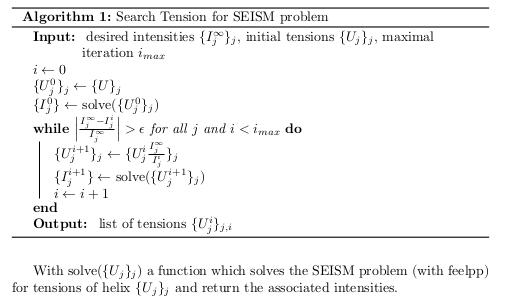
Algorithme of search of Tensions
|
We can represent this algorithm by diagram :
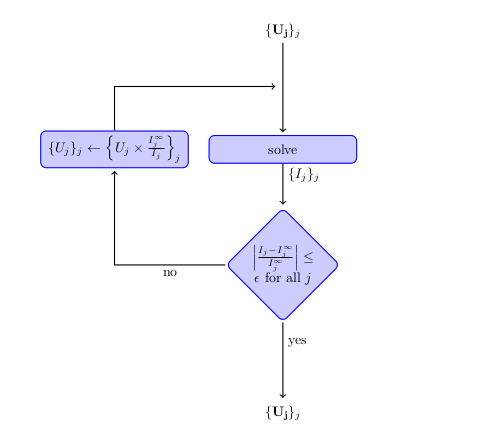
Diagram of search of Tensions
|
The solve function solves the static case to reduce the time of compute. The feelpp’s file of static simulation are here : seism_static.cfg and seism_static.json.
This algorithm is implement on python3’s language with feelpp the python’s module for feelpp : Edit the file.
11. Numeric Parameters
This section show the parameters used to compute the simulation.
-
Size of mesh :
-
Near of Helix : \(h = 1 \, mm\)
-
Near of
Infinie: \(h = 10 \, mm\)
-
-
Time Parameters :
-
Time step : I use adaptative time step. Near of brutal changement of current, the time step is little, in other case, the time step is big. I put adaptative time step to have good precision near of changement (cut of current at \(t=22s\)) and to not explose the time of compute. The shell script feelpp_adaptative.sh implements that.
\(\Delta_t = \left\{ \begin{matrix} 0.1s \, \text{for} \, 0s<t<0.9s \\ 0.008s \, \text{for} \, 0.9s<t<1.1s \\ 0.1s \, \text{for} \, 1.1s<t<19.9s \\ 0.008s \, \text{for} \, 19.9s<t<20.1s \\ 0.1 \, \text{for} \, 20.1s<t<22s \end{matrix} \right.\)
-
Initial Time : \(0 \, s\)
-
Final Time : \(22 \, s\)
-
-
Element type : \(P2\) for magnetic equation (\(\mathbf{A}\) and \(P1\) heat equation (\(T\))
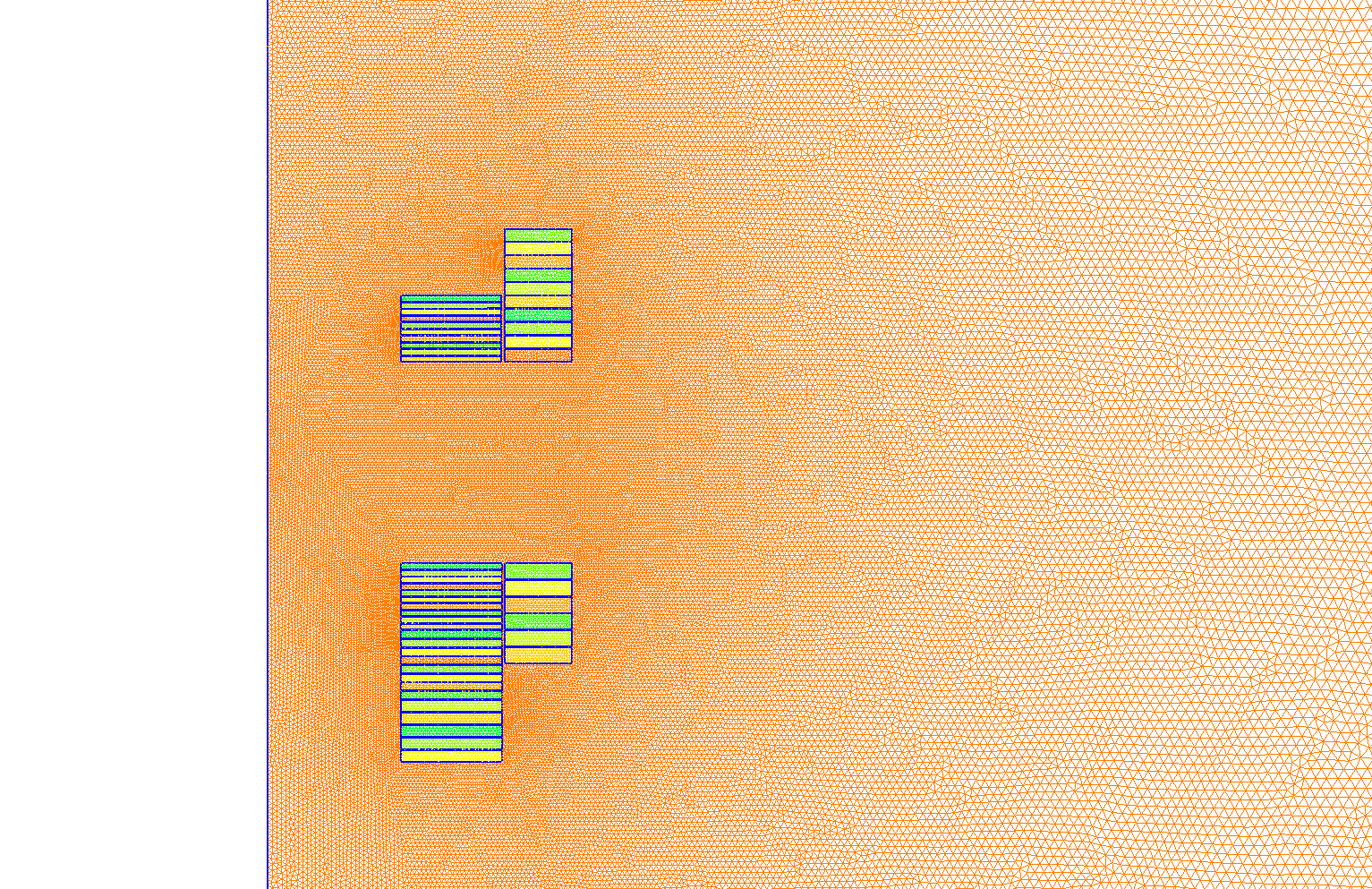
Mesh of Geometry
|
12. Results
12.1. Tensions
We obtain the tensions associate to intensities :
Physical Quantity |
|
|
|
|
|
|
Unit |
\(I\) |
\(7000\) |
\(7000\) |
\(7000\) |
\(-7000\) |
\(7000\) |
\(-7000\) |
\(A\) |
\(U\) for Linear case |
\(-0.499\) |
\(-0.734\) |
\(-0.979\) |
\(0.870\) |
\(-0.828\) |
\(0.929\) |
\(Volt\) |
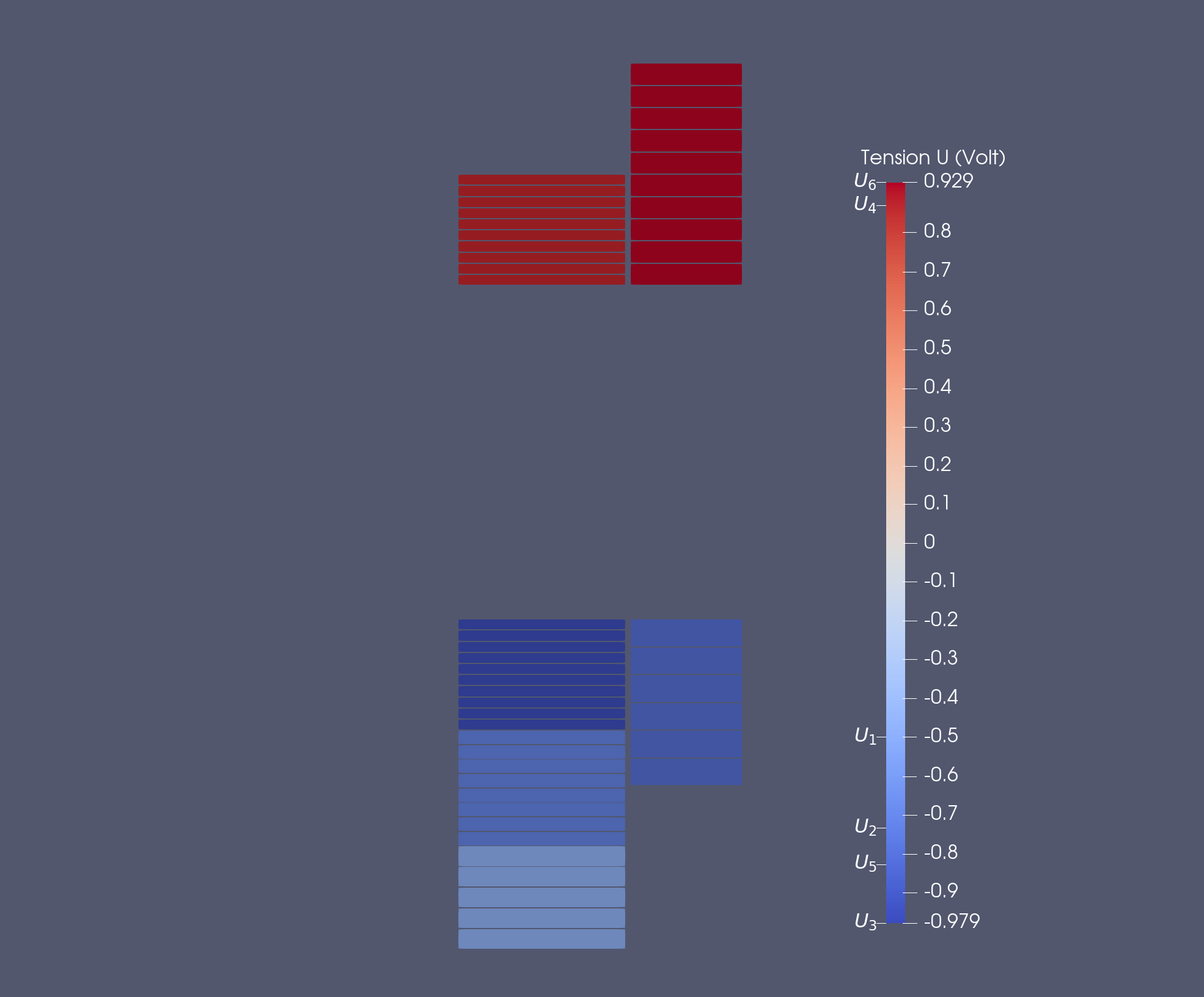
Tensions \(U (Volt)\) for Linear Case
|

Tensions \(U (Volt)\) for Non-Linear Case
|
The algorithm of tension’s searching need 2 cycles for Linear case and 13 cycles for Non-Linear case to converge with the input relative error \(\epsilon = 1e-3\).
In fact, the algorithm guarantees an relative error on intensities of \(1e-14\) for Linear case. Is it normal because, we have \(U = R I\) with \(R\) a constant, thus :
We have : \(U^1_j = U^0_j \frac{I^{\infty}_j}{I^0_j}\)
In the other hand : \(U^0_j = R I^0_j\) and \(U^1_j = R I^1_j\)
Thus : \(R I^{\infty}_j = R I^1_j\) and \(I^1_j = I^{\infty}_j\)
For Non-Linear case, the resistances depends of intensities, thus with the same reasonment, we have just \(I^{i+1}_j = \frac{R^i_j}{R^{i+1}_j} \, I^{\infty}_j\).
12.2. Magnetic Field
We obtain the magnetic field in stationnary case :
13. Reference
-
Status of SEISM Experiments, M. Marie-Jeanne, J. Angot, P. Balint, November 29 2011, Sydney Australia Download the PDF
-
Laboratoire de Physique Subatomique & Cosmologie, IN2P3 (CNRS), Université Grenoble Alpes, website, link of website
